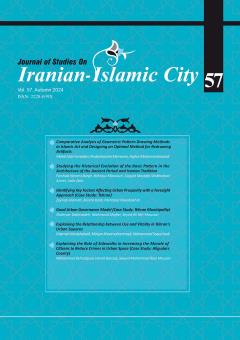تحلیل تطبیقی شیوههای ترسیم نقوش هندسی در هنر اسلامی و طراحی روشی بهینه در بازترسیم آثار
الموضوعات : Islamic Architecture
مهدی عزیزی همدانی
1
![]() ,
غلامحسین معماریان
2
,
غلامحسین معماریان
2
![]() ,
اصغر محمدمرادی
3
,
اصغر محمدمرادی
3
![]()
1 - دانشجوی دکتری معماری، دانشکده معماری و شهرسازی، دانشگاه علم و صنعت ایران، تهران
2 - استاد دانشکده معماری و شهرسازی، دانشگاه علم و صنعت ایران، تهران، ایران
3 - استاد گروه مرمت، دانشگاه علم و صنعت ایران، تهران، ایران
الکلمات المفتاحية: نقوش هندسی, گره, روش بهینه, شیوه چندضلعی, شبکهای, زیرساخت شعاعی,
ملخص المقالة :
نقوش هندسی با قدمت بیش از هزار سال شاخهای از هنرهای اسلامی است. در قرن اخیر پژوهشگران و شرقشناسان علاقهمند به هنرهای اسلامی سعی در بیان شیوههای متفاوتی برای فهم این نقوش نمودهاند. هدف این مقاله ارائه روشی بهینه برای شناخت و بازآفرینی نقوش هندسی در معماری اسلامی و ایرانی است تا زمینه بهکارگیری این الگوها در طراحی امروزی و انتقال دانش به نسل آینده را فراهم سازد. بدینمنظور با بررسی چهار شیوه اصلی ترسیم نقوش شامل شیوههای چندضلعی، زیرساخت شعاعی، شمسه مرکزی و شبکهای، مزایا و محدودیتهای هر شیوه از طریق مطالعه متون تاریخی، کتب استادکاران و ارزیابی معیارهایی مانند دقت هندسی، انعطافپذیری و سهولت آموزش مورد بررسی قرار گرفت. یافتهها نشان میدهد روشهای ترسیمی عموماً امکان ترسیم تعدادی از نقوش هندسی را فراهم میکنند و تنها بازترسیم دقیق طرحهای تاریخی را ممکن میکنند، اما بستری برای ابداع نقوش جدید با حفظ چارچوب هندسی اصیل فراهم نمیسازند. اگرچه شیوههایی مانند شبکهای برای الگوهای ساده یا چندضلعی برای تنوع طرحها مفیدند، اما در مواجهه با نقوش پیچیده و ترکیبی انعطاف کمتری دارند. در انتها با بیان هدف اصلی شیوه ترسیم نقوش هندسی که فهم و بازترسیم نمونههای موجود در بناهای تاریخی است، روشی بهینه در فهم و باز ترسیم این نقوش ارائه گردید. بدینمنظور در چهار مرحله شامل شناخت و رابطه شمسهها و زمینه قابل تکرار و زوایای بهکار رفته در گره و اتصال فاصله بین شمسهها شیوه بهینه تبیین شده و در انتها با سایر شیوهها مقایسه میگردد.
حاجی قاسمی، کامبیز و کامبیز نوایی (1390) خشت و خیال، تهران، سروش
. حلی، علیاکبر (1356) گرهها و قوسها در معماری اسلامی، قم، مهر
. زمرشیدی، حسین و علی صادقی حبیبآباد (1395) تزیینهای معماری در بارگاه و بقاع متبرکه امامزادگان مبتنی بر نقوش اسلامی، مطالعات شهر ایرانی- اسلامی، 7(24)، صص 5-20
. https://sid.ir/paper/499908/fa دلزنده، علی و همکاران (1403) مرتبهبندی تعاریف و شیوههای نگرش به معماری اسلامی برپایه شناختشناسی و هستیشناسی اسلامی مطالعات شهر ایرانی- اسلامی54 (14)، صص83-100
. http://iic.ihss.ac.ir/fa/Article/41039 زمرشیدی، حسین (1390) مسجد بینظیر جامع گوهرشاد و هنرهای قدسی معماری، مطالعات شهر ایرانی- اسلامی، صص ۷-۳۲، (۶)۲
.http://noo.rs/BKMWI السعید، عصام و عایشه پارمان (1368) نقشهای هندسی در هنر اسلامی، مترجم مسعود رجب نیا، تهران، سروش
. شاکرسلمان، عامر (1383) همآراستگی در نگارههای اسلامی، مترجم آقاربیع، به نشر
. شعرباف، اصغر (1385) گره و کاربندی، تهران، سازمان میراث فرهنگی کشور
. طاهری، جعفر (1390) «نقدی بر تحقیق و تصحیح «ترجمه النجارة» بوزجانی»، کتاب ماه علوم و فنون، 35، صص 53-57
. https://manuscript.isc.ac/Inventory/8/616879.htm طاهری، جعفر (1390) نقش ریاضیدانان در معماری به روایت متون دوره اسلامی، تاریخ علم، 9(10)، صص 39-65
. https://sid.ir/paper/ 146574/fa کریچلو، کیس (1389) تحليل مضامين جهانشناختي نقوش اسلامي، مترجم آذرکار، حکمت
. گلیار، محمد (۱۳۹۹) دفترگره، میراث اهل قلم
. لرزاده، حسین (۱۳۵۸) هنرهای از یاد رفته معماری اسلامی، جلد اول، تهران
. ماهرالنقش، محمود (۱۳۶۱) کاشی کاری در ایران دوره اسلامی، شرکت افست
. نجیب اوغلو، گلرو (1389) هندسه و تزیین در معماری اسلامی، مترجم قیومی، روزنه
. نوریان، یحیی و محمدحسین کسرائی (۱۳۹۵) «مقایسه گرههای سنتی و الگوهای معاصر اسلامی با تمرکز بر کاربرد در معماری معاصر»، فرهنگ معماری و شهرسازی اسلامی، (2)، صص 63-75
. http://ciauj-tabriziau.ir/article-1-105-fa.html Abdullahi, Yahya & Mohamed Rashid Bin Embi (2013) “Evolution of Islamic geometric patterns. Frontiers of Architectural Research 2(2): 243–51. https://doi.org/10.1016/j.foar.2013.03.002
. Bonner, J. (2017) Islamic Geometric Patterns: Their Historical Development and Traditional Methods of Construction. In Islamic Geometric Patterns: Their Historical Development and Traditional Methods of Construction. https://doi.org/10.1007/978-1-4419-0217-7
. Bonner, J., Pelletier, M., & Box, P. O. (2012) A 7-Fold System for Creating Islamic Geometric Patterns Part 1: Historical Antecedents
. Bonner, J.F. (2012) Creating Non-Systematic Islamic Geometric Patterns with Complex Combinations of Star Forms. https://www.semanticscholar.org/paper/Creating-Non-Systematic-Islamic-Geometric-Patterns-Bonner/f0435a2886804b06a6a46010c715dd6ee3092fb4?utm_source=direct_link
. Castera, J. M., Peuriot, F. oise, Ploquin, P., & McElhearn, K (1999) Arabesques. Decorative Art in Morocco (Slp edition). Art Creation Realisation
. Cromwell, P. (2023) Geometric Architectural Ornament of the Seljuks in Asia Minor. https://doi.org/10.13140/RG.2.2.35205.52969
. El-Said, Issam and Ayse Parman (1976) Geometric Concepts in Islamic Art. Palo Alto, CA: Dale Seymour Pubn
. https://www.semanticscholar.org/paper/A-7-Fold-System-for-Creating-Islamic-Geometric-Part-Pelletier/6916c9214f267e17ae3f8c68c724fdfa78e73d9e?utm_source=direct_link
. Lee, T., & August, A. S. (2014) The Geometric Rosette: Analysis of an Islamic decorative motif. https://www.semanticscholar.org/paper/The-Geometric-Rosette-%3A-analysis-of-an-Islamic-Lee-August/29f33d97a25d88ff187585277edb8d4f208d152a#citing-papers
. Majewski, M. (2020) Understanding Geometric Pattern and its Geometry, Part 2 -Decagonal Diversity. The Electronic Journal of Mathematics and Technology, 14, 87–106
. Majewski, M. (2022) Understanding Geometric Pattern and its Geometry, Part 7—What can go wrong? The Electronic Journal of Mathematics and Technology, 16, 73–91
. Necipoğlu, G. (2017) The Arts of Ornamental Geometry. Brill. https://brill.com/display/title/32181
. Wichmann, B., & Wade, D. (2017) Islamic Design: A Mathematical Approach. Birkhäuser Basel. https://doi.org/10.1007/978-3-319-69977-6
.


